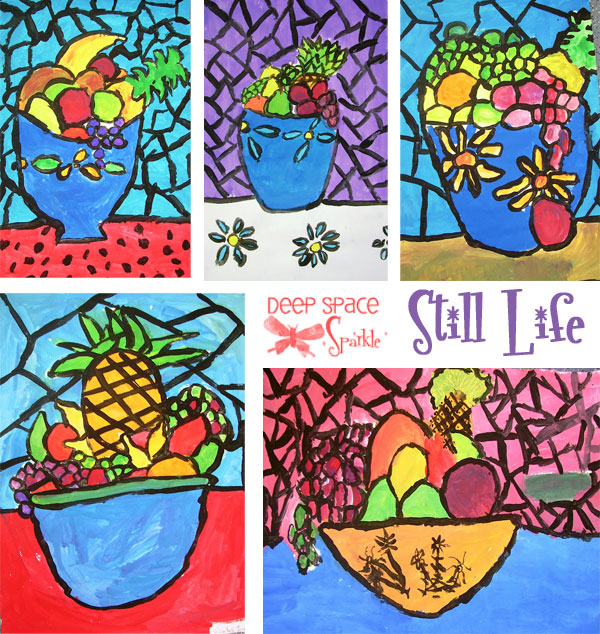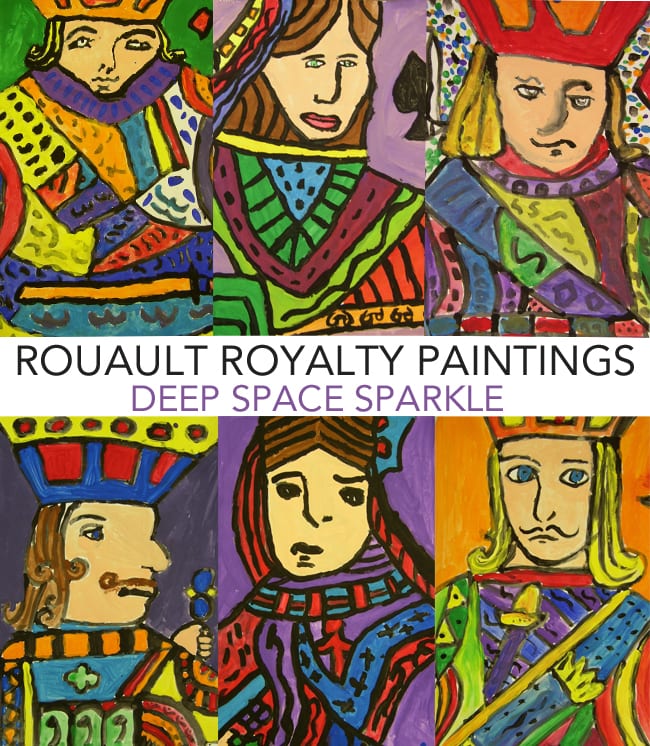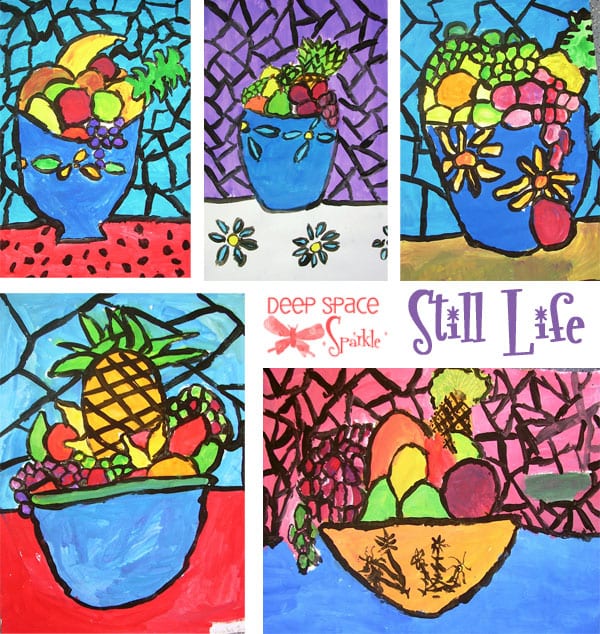These are some of my favorite art lessons for kids. It combines a couple of my favorite techniques…double-loading of the paint and black paint outline.
Inspired by the French artist Georges Rouault, these lessons are designed to teach the children about light and how to achieve it within a painting by painting a still life or by painting royalty.
OPTION ONE: Fifth Grade Still Life
What You’ll Need:
– 12″ x 18″ sulphite paper
– Liquid tempera paints (premixed)
– Muffin type paint palettes
– Paintbrushes
Getting Started:
First the children draw a still life from a bowl of fruit I place in the middle of the classroom. I encourage them to keep the shapes simple.
Once they are happy with their composition, I bring out the tempera paints. Pre-mixed paints, in a variety of jewel tones, are placed in my standard muffin-type paint palettes.
Next, I teach the kids how to double-load their brushes by first dipping in one color (and not stirring) then carefully dip in another. With two colors on one brush, the children gently paint on the drawing. The effects are wonderful. It’s important that the kids keep the colors as they are applied–don’t repaint the area or else the paint will blend together.
I encourage the children to consider the colors in the fruit (i.e. grapes have both red and purple). Have them dip their brush in the two colors to see what happens.
Once the fruit bowl is finished, the children are instructed to paint a simple background and tablecloth. Black paint is then used to outline everything. Then, for the final touch, they can add stain glass panes. This lesson takes 2 @ 60-minute lessons to complete.

OPTION TWO: Rouault Royalty Painting
This art project is adapted from one the Arts Attack video art lessons. The main goal of this lesson is to teach the double-loading technique.
As the students dip their paintbrushes first in one color, then another, a special effect is created. Georges Rouault was a master at creating light in his paintings. Many of his pieces look like stained glass, which is the affect we are trying to achieve.
What You’ll Need:
– Playing cards
– Liquid tempera paint (red, blue, yellow, purple, white and green)
– Paintbrushes
– 12″ x 18″ sulphite paper
What We Did:
I hand out playing cards to each student and then teach them how to approach drawing the top half of the card. We start with a very small brush and black tempera paint mixed with a bit of water. No pencils, erasers or markers…straight in with the paint!
At first, the kids freak out, but then after I show them how to start with the head, then the hair, profile and then shoulders, they get to see that it’s just a matter of lines. Of course, I always stress that they can make no mistakes and whatever happens, is exclusively theirs alone.
By the end of the first lesson, most kids are ready to move onto the second stage.
I put out 6 tempera paint colors that will blend nicely with one another and when mixed, will form a new color. (red, blue, yellow, purple, white and green)
The students paint each section of their work a different color, focusing on creating layers of paint with their brush. I tell them to look for the two colors when they apply their double loaded brush to the page. The colors shouldn’t be mixed.
The final step is to repaint the black lines.
This is a very impressive project and surprisingly enough, only takes 2 @ 60-minute lessons to complete.

ARE YOU A SPARKLER? Over 300 art lessons are available inside the Members Club. Access to videos, resources & trainings for one low monthly fee.
CLICK THE IMAGE TO SIGN UP FOR NOTIFICATION OF OUR NEXT ENROLLMENT














What type of paints are used? Tempra? Could you explain the double loading of paint? Is the object to blend colors on paper?
Thank you.
I used tempera paints here. The purpose of double loading is to blend colors directly onto the paper, not in a palette. Although in this project, I encouraged the kids not to blend the colors too much. You want the streaks of each color to be clearly seen. It’s a nice effect.
How long does this art project take to complete? I’ve been cut back to 40 minutes for art classes. 🙁
Moira
It depends on your grade level. 40-minutes is actually what I had with my K-3. Don’t worry about how much time you have, just break down the project into manageable chunks. 5th graders can do a lot in 40 minutes, so count on this project taking 3-4 class sessions. Maybe less depending on how you teach, how many kids, how well the kids behave… you get the idea!
Thanks! I’ll keep that in mind. I have my classes every other week so they only get art 18 times a year at the max. I will definitely give this a go!
Moira